
A rock crystal vase is a vase made of rock crystal, a type of hardstone carving. Such vases were rare, expensive, and decorated with gold and jewels, used by royalty in Europe.

A rock crystal vase is a vase made of rock crystal, a type of hardstone carving. Such vases were rare, expensive, and decorated with gold and jewels, used by royalty in Europe.
A rock crystal vase {fr} with honeycomb decoration that probably originated from either the Sassanid (6th-7th century) or post-Sassanid (9th-10th century) period that was given to Duke William IX of Aquitaine (the Troubadour) by a Muslim ally (Abd al-Malik Imad ad-Dawla [1] as referred in Latinised form as Mitadolus on the inscription). When Duchess Eleanor of Aquitaine, William IX's granddaughter, married King Louis VII of France in 1137, she gave him the rock crystal vase as a wedding present. The inscription finally says that the king gave it to Suger, [2] who in turn offered it to the saints, to be kept at the Abbey of St.-Denis which he had rebuilt. The vase is now in the Louvre in Paris, and is the only artefact of Eleanor's known to exist today.
Another was a crystal and gold posset that the Spanish ambassador gave Queen Mary I of England and Philip of Spain as a betrothal gift. It was made by Benvenuto Cellini and the whole set is now on display at Hatfield House in England.
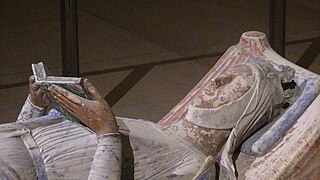
Eleanor of Aquitaine was Duchess of Aquitaine in her own right from 1137 to 1204, Queen of France from 1137 to 1152 as the wife of King Louis VII, and Queen of England from 1154 to 1189 as the wife of King Henry II. As the heiress of the House of Poitiers, which controlled much of southwestern France, she was one of the wealthiest and most powerful women in Western Europe during the High Middle Ages. Militarily, she was a key leading figure in the Second Crusade, and in a revolt in favour of her son. Culturally, she was a patron of poets such as Wace, Benoît de Sainte-Maure, and Bernart de Ventadorn, and of the arts of the High Middle Ages.

Richard I, known as Richard Cœur de Lion or Richard the Lionheart because of his reputation as a great military leader and warrior, was King of England from 1189 until his death in 1199. He also ruled as Duke of Normandy, Aquitaine, and Gascony; Lord of Cyprus; Count of Poitiers, Anjou, Maine, and Nantes; and was overlord of Brittany at various times during the same period. He was the third of five sons of Henry II of England and Eleanor of Aquitaine and seemed unlikely to become king, but his two elder brothers predeceased their father.

Louis VII, called the Younger, or the Young, was King of the Franks from 1137 to 1180. He was the son and successor of King Louis VI and married Duchess Eleanor of Aquitaine, one of the wealthiest and most powerful women in western Europe. The marriage temporarily extended the Capetian lands to the Pyrenees.

Berengaria of Navarre was Queen of England as the wife of Richard I of England. She was the eldest daughter of Sancho VI of Navarre and Sancha of Castile. As is the case with many of the medieval English queens, little is known of her life.
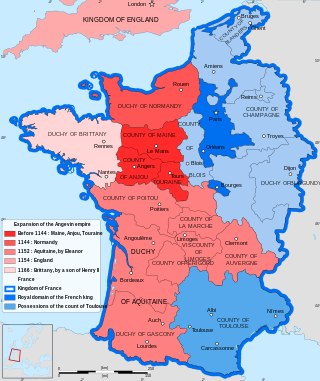
The Duke of Aquitaine was the ruler of the medieval region of Aquitaine under the supremacy of Frankish, English, and later French kings.
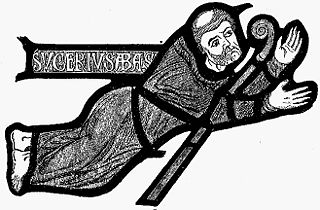
Suger was a French abbot, statesman, and historian. He once lived at the court of Pope Calixtus II in Maguelonne, France. He later became abbot of Saint-Denis, and became a close confidant to King Louis VII, even becoming his regent when the king left for the Second Crusade. Together with the king, he played a part in the centralization in the growing French Kingdom. He authored writings on abbey construction and was one of the earliest patrons of Gothic architecture and is seen as widely credited with popularizing the style.
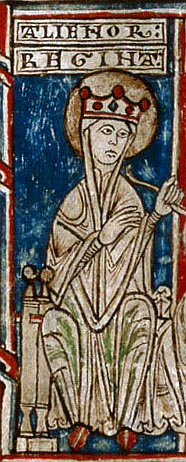
Eleanor of England, was Queen of Castile and Toledo as wife of Alfonso VIII of Castile. She was the sixth child and second daughter of Henry II, King of England, and Eleanor of Aquitaine. She served as Regent of Castile during the minority of her son Henry I for 26 days between the death of her spouse and her own death in 1214.
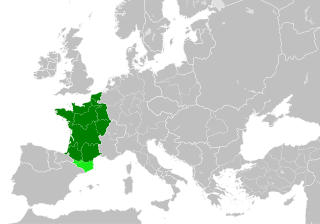
The Kingdom of France in the Middle Ages was marked by the fragmentation of the Carolingian Empire and West Francia (843–987); the expansion of royal control by the House of Capet (987–1328), including their struggles with the virtually independent principalities, and the creation and extension of administrative/state control in the 13th century; and the rise of the House of Valois (1328–1589), including the protracted dynastic crisis against the House of Plantagenet and their Angevin Empire, culminating in the Hundred Years' War (1337–1453), which laid the seeds for a more centralized and expanded state in the early modern period and the creation of a sense of French identity.
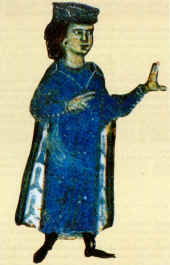
William IX, called the Troubadour, was the Duke of Aquitaine and Gascony and Count of Poitou between 1086 and his death. He was also one of the leaders of the Crusade of 1101. Though his political and military achievements have a certain historical importance, he is best known as the earliest troubadour—a vernacular lyric poet in the Occitan language—whose work survives.
William X, called the Saint, was Duke of Aquitaine, Duke of Gascony, and Count of Poitou from 1126 to 1137.

The Duchy of Aquitaine was a historical fiefdom in western, central, and southern areas of present-day France to the south of the river Loire, although its extent, as well as its name, fluctuated greatly over the centuries, at times comprising much of what is now southwestern France (Gascony) and central France.
The count of Toulouse was the ruler of Toulouse during the 8th to 13th centuries. Originating as vassals of the Frankish kings, the hereditary counts ruled the city of Toulouse and its surrounding county from the late 9th century until 1270. The counts and other family members were also at various times counts of Quercy, Rouergue, Albi, and Nîmes, and sometimes margraves of Septimania and Provence. Count Raymond IV founded the Crusader state of Tripoli, and his descendants were also counts there. They reached the zenith of their power during the 11th and 12th centuries, but after the Albigensian Crusade the county fell to the kingdom of France, nominally in 1229 and de facto in 1271.

The term Angevin Empire describes the possessions held by the House of Plantagenet during the 12th and 13th centuries, when they ruled over an area covering roughly all of present-day England, half of France, and parts of Ireland and Wales, and had further influence over much of the remaining British Isles. It may be described as an early example of a composite monarchy. The empire was established by Henry II of England, who succeeded his father Geoffrey as Duke of Normandy and Count of Anjou. Henry married Eleanor of Aquitaine in 1152, acquiring the Duchy of Aquitaine, and inherited his mother Empress Matilda's claim to the English throne, succeeding his rival Stephen in 1154. Although their title of highest rank came from the Kingdom of England, the Plantagenets held court primarily on the continent at Angers in Anjou, and at Chinon in Touraine.
William IV of Toulouse was Count of Toulouse, Margrave of Provence, and Duke of Narbonne from 1061 to 1094. He was the son of Pons of Toulouse and Almodis de la Marche. He was married to Emma of Mortain, daughter of Robert, Count of Mortain, who gave him one daughter, Philippa.

The Banu Hud were an Arab dynasty that ruled the taifa of Zaragoza from 1039 until 1110.

The Ramnulfids, or the House of Poitiers, were a French dynasty of Frankish origin ruling the County of Poitou and Duchy of Aquitaine in the 9th through 12th centuries. Their power base shifted from Toulouse to Poitou. In the early 10th century, they contested the dominance of northern Aquitaine and the ducal title to the whole with the House of Auvergne. In 1032, they inherited the Duchy of Gascony, thus uniting it with Aquitaine. By the end of the 11th century, they were the dominant power in the southwestern third of France. The founder of the family was Ramnulf I, who became count in 835.

The Cup of the Ptolemies, also known as the Cup of Saint Denis, is an onyx cameo two-handled cup, or kantharos. The cup, decorated with Dionysiac vignettes and emblems, was carved at some point in Classical Antiquity, probably in Alexandria. Eventually, it found its way into the treasury of the French kingdom, before it was donated to the abbey of St. Denis. During the Middle Ages, it was used as a Christian chalice, and lavish mounts were added, with Latin inscriptions. In 1804, the cup was stolen, and the mounts were lost, although the cup itself was recovered. It is now in the Cabinet des Médailles at the Bibliothèque nationale de France, Paris.

Hardstone carving, in art history and archaeology, is the artistic carving of semi-precious stones, such as jade, rock crystal, agate, onyx, jasper, serpentinite, or carnelian, and for objects made in this way. Normally the objects are small, and the category overlaps with both jewellery and sculpture. Hardstone carving is sometimes referred to by the Italian term pietre dure; however, pietra dura is the common term used for stone inlay work, which causes some confusion.

Suger's Eagle is an ancient Egyptian porphyry vase mounted in a medieval silver-gilt eagle. It is now displayed along with the French regalia in the Galerie d'Apollon at the Louvre.
The Treasury of Saint-Denis, kept at the Basilica of Saint-Denis in Paris until the French Revolution, was the main repository of the regalia of the Kingdom of France, including the ancien régime portion of what are now known as the French Crown Jewels. Its surviving items are presently scattered between the Louvre, the Cabinet des Médailles of the French National Library, and other museums.